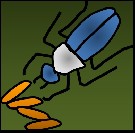Blast

Blast is caused by the fungus Pyricularia oryzae. Blast can infest any organ of the plant: leaf, neck, panicle rachis, stem node, grain, etc. When the disease attacks the leaves, we talk of leaf blast. There are other kinds of blast: neck blast when the base of the panicle starts to rot, and node blast at the level of the stem nodes (see photo above). When blast infests the neck of the panicle, nutrients cannot reach the grains.
The disease multiplies rapidly by spores, multiplying on leaves and panicles, which then penetrate into tissues; a few days later, the lesions or symptoms appear. The tips of leaf lesions are typically spindle-shaped, wide in the center and pointed at the ends. Large lesions usually develop gray centers bordered by brown to dark red. Chlorophyll disappears in the parts attacked, which means that photosynthesis and yield are reduced.
On the base of the ear, the same symptoms can be present (neck blast): blast infects the tissue, the ear pivots and breaks off. If the infestation starts at the milky grain stage, the panicle remains empty; if it starts later, the grains do not fill well and the rice quality is affected (chalky, brittle or greenish). Stem blast causes soft rot at node level, the nodes break resulting in different degrees of damage depending on the crop development stage. Blast is favored by too high a dose of nitrogen and high humidity.
Extract from PLAR-IRM Curriculum: Technical Manual (Wopereis et al., 2009)













